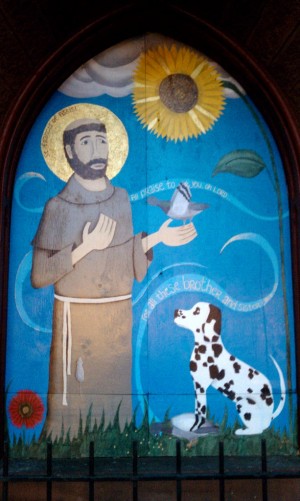Luther Place: Sacred Commons, Social Justice

DCentric
Luther Place's first mural: Saint Francis of Assisi-- and a congregant's Dalmatian!
Earlier today, I published the first part of an interview with Reverend Karen Brau of Thomas Circle’s Luther Place church; they just dedicated a mural on the 14th street side of their building to “Saint Martin of Birmingham”, whom you may know as the late Rev. Dr. Martin Luther King, Jr. Here’s the remainder of our conversation, as promised:
Where did the idea for this mural come from– what inspired it?
I’ve been at Luther Place for two years; I came from inner-city Baltimore where I worked in neighborhood ministry…we did things with vacant lots, gardening and art. In Baltimore, we had the gift of many vacant lots. Here, that’s not the case, so we thought ‘how do we use what we have?’ Instead of putting up a big fence and having it be just our space…we explored what commonality means by sharing this art outside.
We are always reforming, we have this sense that God is calling us to new things. We looked at the space around Luther Place and we realized that some people will never come inside our church, so how could we honor the outside of it? How could we reach others? By a Sacred Commons. “Sacred” in that it’s holy ground, “Commons” in that it’s held in common by anyone who comes through. It’s also “sacred” in the sense that all people are sacred or children of God, and “common” in that we have the possibility of finding new ways to share and live in common. We need places to practice what that means.
Public art as outreach?
When we looked at our space outside, we chose to include art, beauty, even large plantings of sunflowers (which were very popular). Then we added these murals. The first one was Saint Francis of Assisi; the new one is of Dr. King. Also, public art is political in the best sense; it’s the art of the possible! What is possible for the church is that we bring forward those parts of church history that are about wholeness and what is possible for the human family. That we learn from saints like Saint Francis or Martin Luther King. We had these abandoned doorways that we weren’t using. I thought it was a great opportunity to bring some beauty to that space. I love murals!
They certainly add something to the neighborhood. What about your other, first mural?
We were thinking about who is in the neighborhood around Luther Place. We noticed a lot of people who have dogs walk them near us, so who better to depict than Saint Francis? We were trying to build a sense of community with that mural showing Saint Francis with this great Dalmation who actually belongs to one of our members.
What does your congregation think of the mural?
People are thrilled because it matches with our congregation…we are a place of hospitality. I think it’s a really good match. The congregation is happy to be able to offer our door for something like this. Amanda Weber is the artist, she works at Luther Place, so there’s also this sense that this is someone who knows our congregation’s story, knows this place, loves this place, but also wants change and social justice. These murals are from an artist from among our community.
Tell me more about Luther Place and social justice.
This is a congregation that speaks frequently about social justice, especially about homelessness and poverty. There’s our ministry with N Street Village, the Steinbruck Center for Urban Studies, a hostel in the church where we have groups come and stay from colleges–another group is coming next week. We facilitate spring break volunteering with different social justice projects about the reality of urban poverty– that’s an ongoing thing. We also participate in the Washington Interfaith Network…we do congregation-based, community organizing through WIN!
The issue for us is, how do we not just talk about social justice but engage in the walk to change things. That’s partly why we used this outdoor space in a city to create what is beautiful; art and gardening can build community and help engage around justice in an urban place.
You’re in a very special location.
This is a neighborhood that had a lot of activity with prostitution and drug dealing before gentrification happened in the late 90s. I think it’s a challenge to look at what that means for our community. Gentrification has two sides to it: one is there are lovely new businesses that are arriving, you can get coffee or a good lunch, but the other side is that there are people and older businesses being displaced.







